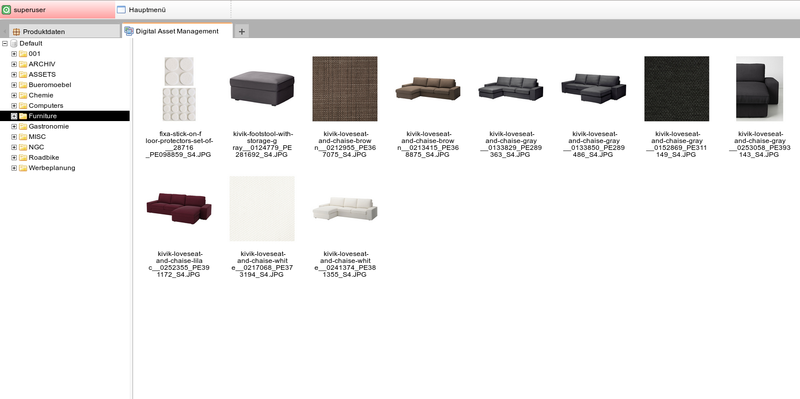Digital Asset Management - more Sales by Effectivity

DAM and MAM – the flood control for your data
Digital Asset Management (also called Media Asset Management or Digital Media Asset Management) is provided by software systems used to manage and sort digital files. In addition to their main function – combating data chaos in companies –, these software systems offer a variety of internal and external benefits for their users.
DAM and MAM for a neoteric online presence
A positive presence on the Internet and a high rank in search engine results are essential for today's businesses.
Modern customers use the Internet to actively inform themselves about new products and are no longer just passively influenced by traditional advertising. If a company wishes to keep its top position on the market, its public presence must focus on customer needs.
Now, to this end, it is possible to influence the status in relation to search engines – if you know how a search engine works:
Search engines evaluate a query, scan any Web page, and compare the results with the search query. The criteria for the search result include details such as the last update of a website, the content, and the specific algorithm used by a search engine. The targeted use of Digital Asset Management can influence the search results and push a company higher in the rankings.
But what exactly are these systems and where is the link to Search Engine Optimization (SEO)?
Assets, metadata & similar – the fundamentals of Digital Asset Management
Content Management Systems (CMS) are administrative software systems. A CMS manages and sorts content and passes it on to other systems (websites or servers, for instance). There is also some additional information that is passed on in addition to the visible content.
As we are interested in systems with a focus on internal and external benefits for companies, we should take a closer look at Digital Asset Management (DAM) and Media Asset Management (MAM).
But let's start with the basic element – the asset:
In connection with a CMS, asset means a set of data or a single file. A file can be an image, a video, a text document or similar. They must be provided in a digital format that can be processed by the system.
The system clearly differentiates between the file as such (the asset) and the additional information.
The additional information is the metadata and is stored in the CMS in conjunction with the asset. Additional information includes facts such as intellectual property rights, the author or creation data of the file. All this information is important for the administrator of a website and the SEO process. To a customer visiting a website this information is not visible.
To correctly save an asset, it is necessary to first of all identify the type of data and its metadata. Multipurpose Internet Mail Extension (MIME Type, also called Content Type or Internet Media Type) automatically identifies the data type, and sorts and "shelves" the asset to the suitable place within the system. Metadata are entered manually or automatically into the system and play a leading role in the search process; the search engine automatically detects metadata and gives a higher priority to it than to other elements on the website. So, it is really essential to have the correct metadata.
Digital Asset Management vs. Media Asset Management (Digital Media Asset Management) – the small but mighty difference
Now, to be able to logically sort and use the assets, especially for a website, a certain kind of CMS is required:
Digital Asset Management is of exactly that kind. As the name "Digital Asset" suggests, a DAM works with digital files. These include images, videos, text documents and similar types of files. The assets are sorted, managed, prepared and stored in a meaningful order.
Media Asset Management systems are a certain type of DAM with a focus on the visualization of images and videos. Image and video files are known to be more complex than a simple text document, which is why MAM systems are often also slightly bigger in size.
The term Digital Media Asset Management is used to describe both types of systems. There is no difference or further development, but the term Digital Media Asset Management sounds better from a marketing perspective and promises something new.

Growing data floods overwhelm companies
The problems faced by companies with respect to data management systems were analyzed in a study of the Business Application Research Center (BARC). In 2015, 290 companies were surveyed on the issue of "Modern Data Management for Analytics". The survey was about the handling of Data Management Systems and what everyday problems the participants came across.
These were the top 3 issues:
1. General data growth
2. Increasing number of data sources
3. The business and technical requirements for data management systems overwhelm the company.
The study revealed two important findings:
In almost all companies, we find an unfortunate combination of a rising data flood and a lack of resources to manage the data.
If companies are overwhelmed by the management of their internal assets, it is almost hopeless to expect a good presentation of their data to external parties.
As we focus on Digital Asset Management and similar software systems, the general "Top 3" come along with certain other issues:
Hardly any company still offers its products on a single platform – as a rule, products are presented on multiple channels and platforms. If something changes in a product, all channels and platforms need to get timely updates.
But already the sharing of information can be difficult: In everyday business, important information can go unnoticed or information is incorrectly passed on following the "Chinese whispers" principle.
Basic communication problems between individual employees or entire departments may present additional problems. In international companies, language barriers are often a source of errors.
But also technology can be a cause for failure: files and important information can get lost due to missing backups and simple server problems.
But the most dangerous everyday thing is the good old data chaos.
A DAM as the solution against growing data floods
The solution for all these problems is simple and yet awesome: Digital Asset Management.
With a suitable DAM, all assets – including the metadata – are entered, sorted, sensibly stored and can be passed on at the click of a mouse, for example, to an online shop, the sales department, or a catalog. Even if entering all files in advance can take much time, the benefits are perfectly obvious:
-
All digital files are centrally stored, managed, and sorted.
-
Files cannot be lost within the DAM.
-
Files are organized into categories and hierarchies.
-
Clear handling of language-related files (videos, pictures with captions, documents...).
-
Metadata can be used individually or applying the IPT-NCAA standard.
-
Files can be saved in different versions.
-
Formatting and converting images can be done directly in the DAM.
-
The entire content of the DAM can be coupled and synchronized with any system.
-
This is just a rough outline of the benefits – there may be more and other benefits depending on the problems faced by the business and the functions offered by the DAM.
Two outstanding features are worth noting: A DAM system saves important resources such as time, which employees can use in significantly more meaningful ways, and server capacities. In the long run, an investment in a well-functioning data management system is also an investment in the future of the company.
DAM & SEO – where's the correlation again?
DAM systems not only store and sort files, but also import metadata including individual keywords. The keywords are the "billboards" of the website with respect to the SEO process.

If all channels and platforms are coupled with the DAM they get metadata and keywords automatically. In addition to the keywords, search engines also register updates on a website and consider this information for the search process.
Feeding matching and new content is more or less done "en passant"; in this way, a company can climb up in search engine results with only little effort.
Efficiency at a glance
As we learned, Digital Asset Management, Media Asset Management & similar offer many internal and external benefits:
From an internal perspective...
-
files are managed centrally and concurrently;
-
changes can be made directly via the Internet;
-
the IT infrastructure does not have to be changed, it is supplemented;
-
servers and employees are relieved by eliminating file server maintenance.
From an external perspective...
-
the website is always up to date;
-
all platforms and channels are updated at the same time;
-
all products are provided with metadata;
-
this leads to a consideration of the website by search engines.
Alterra DAM brings order to internal and external media assets
Alterra DAM is a very comprehensive Digital Asset Management System. Tailored to the needs of a company and its products, Alterra DAM supports companies both internally and externally: Via a simple data management function, products are categorized and hierarchically entered, and the integrated search function ensures that any information can be quickly found – minimizing the loss of important files. Converting images and videos can be done in the software itself, no additional external programs must be used. Metadata and search properties can be assigned manually. Externally, the proper metadata influence the ranking in search engine results – the company is more visible for new customers on the Internet.
Go to Alterra DAM - Digital Asset Management >>>>
Contact
Sepia GmbH & Co. KG
Ernst-Gnoss-Strasse 22
D-40219 Düsseldorf - Germany
Phone: +49 211 51 419 75
Phone alternative: +49 211 74 958 712 0
E-Mail: info@sepia.de
Looking for consultation or a web demo?
Get it here.
Projektberichte
Lesen Sie diese Projektberichte über die Integration von Alterra PIM:
- Segmüller
- abholen.de von EDEKA
- Toshiba Europe
- Messer Group
- WENKO Wohnideen
- Thermokon Sensortechnik
- Halfen Group
- M+W Dental
- Stahlwille
- WASI
- Rudolf Müller Verlag
Diese international operierenden Unternehmen haben mit Hilfe von Alterra PIM erfolgreich ihr Produktdaten-Management verbessert.
